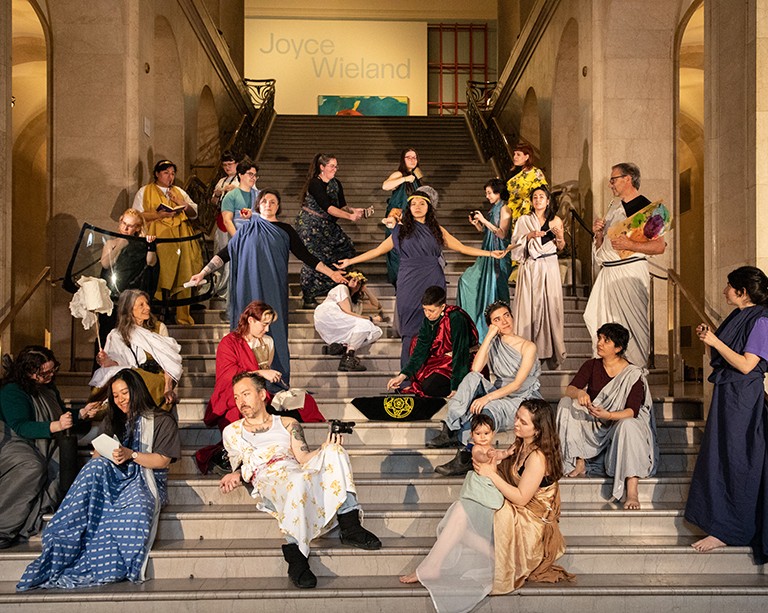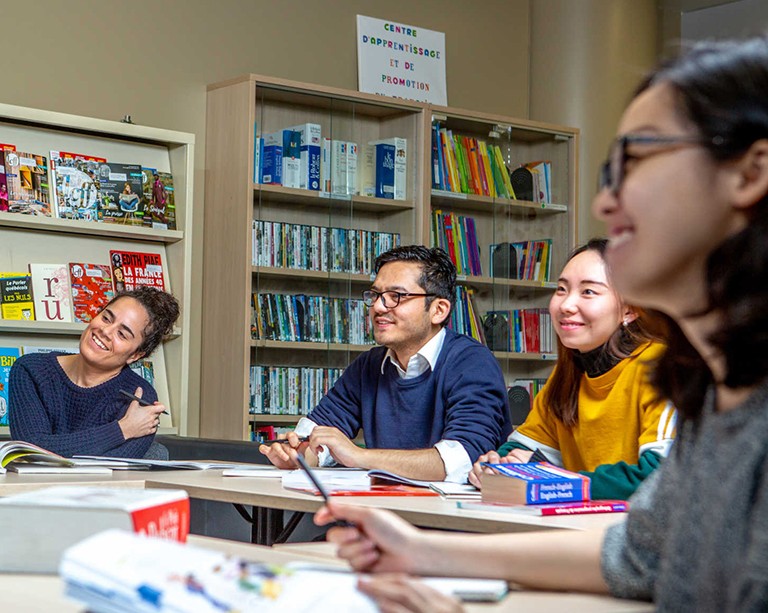Concordia engineering students collaborate with the FOFA Gallery to phase out vinyl exhibition signage

Concordia’s FOFA Gallery is collaborating with engineering students to develop a signage printing machine aimed at phasing out vinyl exhibition signage. Supported by a Cultivate Grant from the Canada Council for the Arts, this initiative is part of the Gallery’s Exploring Sustainability Across the Arts (ESA) project.
As part of their undergraduate capstone projects, two teams have been tasked with developing separate components of the printing machine — one with the printer head and the other, with the motion/movement.
Engineering student Johannie Lamoureux says her team eagerly embraced this rare opportunity for collaboration outside of their department. “We were super excited to work with the Faculty of Fine Arts — we never get to collaborate with them!”
Creating real impact
Co-curators in Sustainability at the FOFA Gallery, Josh Jensen and Joé Côté-Rancourt note that this initiative supports the Gallery’s ESA project.
“The life cycle of exhibition signage is so short that low-impact material is the only sustainable approach. The proposed project could give us a reusable way to approach really large-scale signage more efficiently,” says Côté-Rancourt.
In addition to these efforts to develop more sustainable signage, Concordia’s FOFA Gallery is now rethinking the use of gallery plinths, the heavy bases or boxes that display artwork in the FOFA Gallery and in exhibitions everywhere.
“Reducing the ecological impact of the ‘immutable gallery’ is challenging, especially when you hope to encourage other art spaces to follow suit. This is the goal — to develop something that works anywhere, to create real impact.”
Nicole Burisch, former director of Concordia's FOFA Gallery, expressed how important it was to her to create a machine that could be adopted by larger museums and galleries. As she notes, “While the FOFA Gallery has funding and space to do more labour-intensive and experimental signage, I know that if we want to see this kind of sustainability work picked up across the sector, we'll need to find solutions that are more efficient and user-friendly."
 From left: William Cyr, Eshwar Ganesan, Bryan Mbyana, and Thua Duc Tan. | On the right: The white PLA section with the nozzle is the head.
From left: William Cyr, Eshwar Ganesan, Bryan Mbyana, and Thua Duc Tan. | On the right: The white PLA section with the nozzle is the head.
Navigating a Sticky Situation
Under the guidance of Michael Rembacz, engineer in residence, each of the two teams is composed of five engineering students. The end goal of each team is to produce a first iteration — of the printer head, and of the movement mechanism — that another group of students can tweak further down the road to ensure compatibility.
Eshwar Ganesan is a member of the team charged with building the printing head. He offered the following analogy to describe the team’s role in the process:
“Every printer has a printing head, which is what deposits a material (be that ink, or in the case of a 3D printer, plastic). Every printer also has some kind of controller that controls how the printer head is moved. So, if a person is writing with a pen, the human is the printer and the pen is the printing head. I think that's the best way to describe it.”
As Ganesan explained, a unique challenge his team faced was ensuring the machine could deposit the specific material requested by the FOFA Gallery — nori paste, a biodegradable rice glue that can be wiped off the wall with just water.
“What exist currently on the market, for signage purposes, are essentially ink printers: they spray ink onto the wall or to whatever surface. That has its own technique, you can use hydraulics and pressure to deposit that ink. But nori paste is essentially a kind of glue.”
His team cannot spray the substance but instead must make a series of tiny deposits via a syringe. Once a chosen pattern or lettering has been transferred to the wall in glue form, a pigmented, granular, or textured material — for example, crushed rock or natural dye — can be applied or mixed into the nori to create the desired signage.
Artists and gallery workers at FOFA have executed this process by hand, but it entails meticulous brushwork and stencils. The new machine will not only speed up the process but also offer far greater precision — making it a potential solution for larger spaces.
“Essentially, we’re replacing that paintbrush,” notes Ganesh, happy for this opportunity to combine his love of engineering with his passion for fine arts. “We're taking a syringe and we're adding a motor — an actuator — to move the piston of the syringe.”
 Signage in nori paste (same material that will be deposit with the robot) + crushed rocks. | Photo: Alexis Bellavance
Signage in nori paste (same material that will be deposit with the robot) + crushed rocks. | Photo: Alexis Bellavance
Moves toward sustainability
Lamoureux’s team is charged with all that makes the robot move and write.
“We have two different systems in our motion system: one moves the robot forward from line to line, and then the gantry system is responsible for printing all the lettering and drawing,” she explains.
“The robot will move to a target position, stop, then the gantry system will print a letter (for example). Then it will move to the next position to print the next letter and so on until it's done the whole wall. The robot stays on the wall during this process, using two fans that generate a suction force.
“I’m super excited about this project; it’s been challenging. There were many alternative solutions, and some were questioning the design we chose to build: they didn’t think it was doable at first because of the complexity and lack of similar existing designs. It’s been super exciting to see. Even our professors were like, ‘Oh, wow, this can actually work.’”
 With & of (Becoming Rock), March 2022 (photo of Jessica Slip exhibition). | Photo by Alexis Bellavance
With & of (Becoming Rock), March 2022 (photo of Jessica Slip exhibition). | Photo by Alexis Bellavance
Ultimately, what drew her team to this challenge was the sustainability angle. The machine will provide a sustainable alternative to vinyl lettering, and their hard work will have a life beyond the capstone project.
As Lamoureux notes, “Sustainability was really an important point for us. We specifically chose this project from a long list of potential projects.
“When Michael Rembacz presented this idea to us — which Nicole Burisch had been excited to share with him — we instantly looked at each other and knew this is what we wanted to do.
“A lot of the projects that students produce end up just being thrown away because they aren’t actually needed. We wanted to produce something that was going to be useful long after we graduate.”
Learn more about Concordia’s Exploring Sustainability Across the Arts (ESA) initiative.


